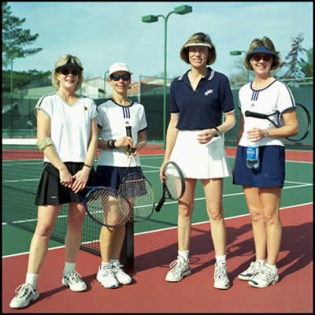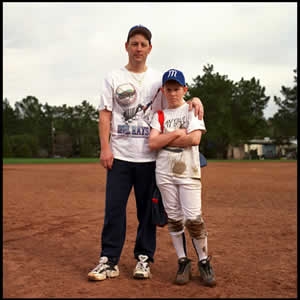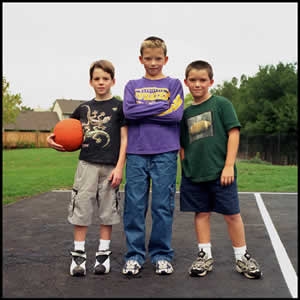Feature: Reviews
Real People/Real Places: Photographs of Community by Allen Spore
- Bedford Gallery
- Dean Lesher Regional Center for the Arts, Walnut Creek
- July 1 - August 26, 2001
Reality Rocks
For a culture that witnessed the release of A.I. and The Final Fantasy in a single week and is enthralled by “reality” TV shows like Survivor, Big Brother, and The Real World — not to mention around-the-clock Webcasts from stranger’s bedrooms — the term “real” has to be a pretty fuzzy concept. What does it mean to be a real person, what is a real place, in a time and a place like the present?
Real People / Real Places — Allen Spore’s remarkable series of large-format color portrait photographs of his friends and neighbors in the affluent Northern California suburb of Moraga — invites serious inquiry into those questions. As much a suburbanite as anyone could be, Spore has lived in Moraga for the past thirty years and raised his family there.
At first glance these are alluring, dignified images, respectful of their subjects’ individuality and informed by empathy — affection, even — an acute eye for composition and detail, and subtle wit. But prolonged scrutiny reveals something disturbing about them: an ineffable strangeness, a faint yet pungent whiff of hyperreality. They begin to look like photographs of habitat groups in a natural history museum. The figures are unnervingly lifelike yet immobilized, frozen, like compelling examples of the taxidermist’s art. They seem to represent members of an endangered, if not already extinct species in what appear to be painstaking reconstructions of their pleasant, if bland, synthetic environments. The images project an elegiac, idealized quality, a sense of in memoriam.
Spore achieves this subtle estrangement of vision partly by exploiting photography’s capacity to arrest a moment in time while conveying the illusion of verisimilitude. He enhances the effect with computer manipulation, subtly sharpening and cleaning up the foreground image, making it resemble a two-dimensional cardboard cutout set against a background slightly out of focus. Those “tennis ladies” — are they really made of flesh?
As interesting as what’s inside each frame is what is absent: not a single black or brown face and only one Asian one, no one apparently gay or transgendered, no one pierced or tattooed or — except for the four adolescent boys in hip hop gear — no one dressed or coifed with the slightest sense of style. No cars or workplaces, no evidence of poverty or homeless people or conflict. No dirt (apart from acceptable mud on a boy’s baseball uniform), no joy, no pain. It’s Leisure World: the tennis court, the playing field, the golf course, the patio, walks in the park with the dogs — the suburban pastoral idyll. The adults look contented, or tensely aware that they ought to look contented. The kids look comfortable, well fed and clothed, and bemused. There’s a vague feeling that all these good people are living in a fool’s paradise, on borrowed time.
Spore has arrived at a formal equivalent for the quintessential suburban artist’s vision in these pictures: that of the insider who simultaneously feels him/herself to be an alienated outsider. In an earlier body of work, produced while he was earning his BFA in photography as a student at the San Francisco Art Institute, Spore paired images of the Moraga Country Club, where he lives, with images taken in Viet Nam thirty years before, when he served as an officer, aviator, and surveillance photographer in the U.S. Army. It was his first attempt to resolve artistically those contradictory realities for himself, an essay in reconciliation. With Real People / Real Places he allows those tensions implicitly to coexist: an act of generosity to viewers who may take from these images what they will.
Commenting on August Sander’s photographs of German social "types" in relation to Joel Sternfeld’s photographic portraits of contemporary Americans, SFMoMA curator Doug Nickel wrote, "Historically, the portrait photograph has functioned as both personal commemoration and sociological document." While Spore’s portraits clearly function in those ways, they are conceptual as well. They present visual analogues for our uneasy navigation among the contradictory realities which simultaneously co-exist in our consciousness, as we wonder which is more credible: our memories, our fantasies, our intuitions of alternative realities, or what we see when we look out the window?
"A successful work," wrote Theodor Adorno, "is not one which resolves objective contradictions in a spurious harmony, but one which expresses the idea of harmony negatively by embodying the contradictions, pure and uncompromised, in its innermost structure." Spore has achieved that negative harmony in Real People/Real Places. It’s an impressive debut.
Real People / Real Places: Photographs of Community by Allen Spore is on view at the Bedford Gallery, Dean Lesher Regional Center for the Arts, Walnut Creek, California through August 26, 2001. For more information, visit http://www.dlrca.org/gallery.info.html or call 925/295-1417.



